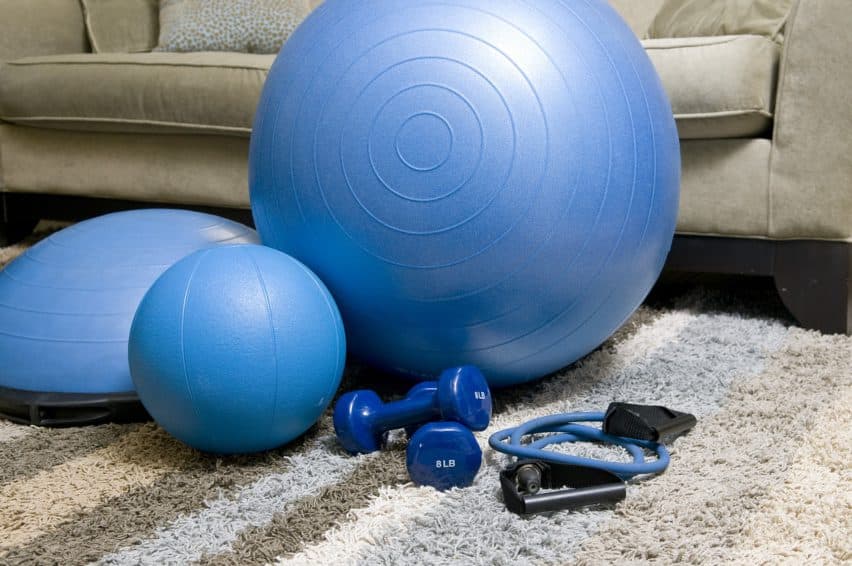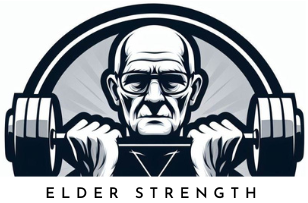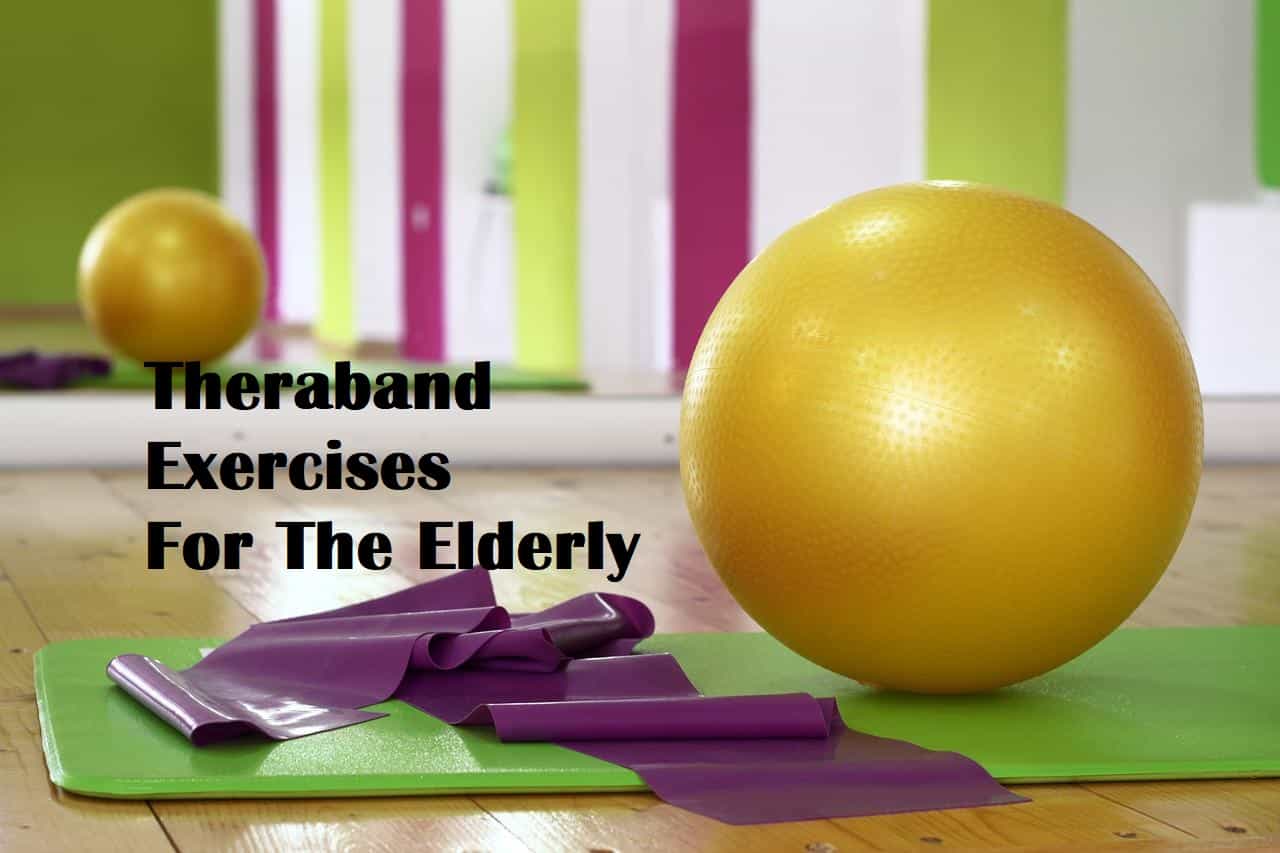In this post, you will learn about Theraband exercises for the elderly. Theraband exercises are great for building mobility and strength for seniors.
This is especially true if you have disabilities that prevent you from doing typical strength training at a gym.
They are also great for doing more versatile home workouts. Because they can add resistance to bodyweight exercises like squats, shoulder presses, and push-ups. So you can do some pretty complex movements with them.
Therabands are especially useful in physiotherapy and rehabilitation. They offer resistance that activates the muscles and can be varied from very light to moderate intensity.
The resistance a Theraband offers is quite different from a weight or a gym machine. The pull of the band increases gradually as you stretch it. The direction of the pull is always towards the band instead of ground like with free weights.
This allows many limb positions to be trained with resistance that is not easily achievable with weights or machines. Useful stuff for rehabilitating a muscle or joint injury for example.
What Is The Theraband
Therabands, also known as resistance bands are elastic bands that offer resistance to exercise. They come in different strengths which dictate the amount of resistance they offer.
Theraband is actually the most well-known brand in the market so they’ve pretty much become synonymous with the resistance band. “Thera” obviously refers to physical therapy. The bands were originally developed for this.
Therabands come in different kinds of arrangements. The most simple and widely used form is a Theraband without any kind of handles. They are simply 4″ wide and 5 feet long latex rubber bands that come in different strengths. That doesn’t make them useless though, they are actually the most versatile form of Theraband.
There are also Theraband with handles. They typically have a tough latex tubing that’s 50 inches long and has handles in the end. They give you more resistance. And naturally a better grip because of the handles. These can also be equipped with something called a door anchor. It allows you to anchor the other end of the band to a door handle for certain exercises.

Theraband consecutive loops are just like the simple band. But instead of being open at the end, are a consecutive circle just like a rubber band. This allows different kinds of movement without the need for necessarily gripping the band.
Finally, there are different kinds of bands that you can use in Theraband wellness stations. They are more oriented to gym use but you can get one for your home as well.
Why Theraband Exercises For The Elderly Are Very Beneficial
Elderly people often have mobility issues and joint paints that prevent certain movements to be performed with proper technique. They can also have huge differences in the strength of different muscle groups. Depending on the activities they’ve been doing their whole life.
Some muscle groups can be so weak that performing typical strength-building exercises is not possible until those muscle groups have been made active again. This is where Theraband exercises shine.
They don’t stress your joints as much and the exercises can be specifically targeted to the muscle group that needs the most strengthening.
The Therabands are also very compact and take no more room than a small scarf. This means they are great home exercise equipment if you have limited space. They are also great for taking with you on a trip.
Many seniors like to take several week-long trips, simply because they can. Therabands are great exercise equipment to take with you.
You can do your exercise routine in a hotel or in a park without having to haul heavy and space-consuming exercise equipment in your luggage.
Therabands are also very affordable. Seniors that want to add challenge to simple bodyweight exercises and can’t afford a gym or expensive home exercise equipment will find the Therabands very useful.
Theraband Strengths
The Theraband products come in four different strengths that are indicated by their color:
- Tan: Very light. 2.4 lbs resistance at 100 % elongation.
- Yellow: Light. 3.0 lbs resistance at 100 % elongation.
- Red: Medium light. 3.7 lbs resistance at 100 % elongation.
- Green: Medium. 4.6 lbs resistance at 100 % elongation.
- Blue: Medium strong. 5.8 lbs resistance at 100 % elongation.
- Black: Strong. 7.3 lbs resistance at 100 % elongation.
- Silver: Extra strong: 10.2 lbs resistance at 100 % elongation.
- Gold: Extreme: 14.2 lbs resistance at 100 % elongation.
Now that we know what the Therabands are and the different forms and strengths they come in, let’s look at some exercises you can do with them!
Seated Theraband Exercises For The Elderly
These seated Theraband exercises are great for seniors with mobility and balance issues. Doing exercises in a sitting position provides you the stability you need to perform them correctly.
You can actually go over most of your muscle groups in a sitting position. The one important muscle group that is very hard to activate in a sitting position however is the so-called posterior chain. I talked more about this in the article Chair Sitting Exercises For Seniors
The posterior chain consists of the hamstrings, glutes, and the lower back. This muscle group is the most important one for overall body strength and athletic ability, so be sure to target it separately.
Theraband Leg Exercises
Leg strength is much more important for the elderly than upper body strength. Your legs are responsible for your ability to move and maintain balance.
Loss of legt strength can be really problematic and reduce your ability to function independently. I talked more about this in the article Weak Legs On Seniors (5 Minute Fix!) and Leg Strengthening Exercises For Seniors [4 Simple Exercises].
To focus more on the legs and the posterior chain, try these Theraband leg exercises by Lazy Dancer Tips (YouTube embed, content not owned or created by ELderStrength.com):
Theraband Exercises For The Shoulders
Therabans are exceptionally good for shoulder exercises. This is because the shoulders are a relatively small muscle group with an extremely wide range of motion. Think about it, the shoulder can go all the way around unlike any other joint in your body.
Because of its high mobility, the shoulder joint is very prone to injuries and mobility issues as well as muscle imbalances as I mentioned I the post Shoulder Strengthening Exercises For Seniors [4 Exercises] and Shoulder Exercises For The Elderly [Simple Guide]
The large muscles that move your shoulder are called the deltoids. The smaller muscles responsible for rotating the shoulder joint are called the rotator cuff.
Especially the posterior deltoids and the rotator cuff are prone to injuries and being weak, while the anterior and middle deltoids are prone to being overactive.
These Theraband exercises by Inspired Physiotherapy are great for the posterior deltoids and the rotator cuff and will ensure your shoulders keep healthy and strong (YouTube embed, content not owned or created by ElderStrength.com):
Conclusion
I hope you enjoyed reading about these tips in Theraband exercises for the elderly. If you have any questions, please present them in the comments section below and we will provide you with an answer as soon as possible.
The Theraband and other resistance bands are great affordable exercise equipment you can take with you anywhere. They are also great for improving muscle imbalances and rehabilitating injuries in the elderly.
The resistance they provide is a bit more gentle and easier to focus on the right muscle group than free weights or gym machines. Always remember to start light and add resistance as you progress. Because Therabands are very affordable, it’s wise to get a whole set with different resistances so you can move to stronger resistance as you become stronger.
Having different strengths is also handy for your different muscle groups. You can typically use much higher resistances in leg exercises than in shoulder exercises for example.
You should also always talk to your physician before starting a new exercise routine just to make sure there aren’t any health problems. That said, Therabands are probably one of the safest forms of resistance training you can do. But it’s always better to be safe than sorry.
If you like to read about strength training and general fitness for the elderly, please bookmark my site and subscribe to my newsletter!
See you next time,
Elder Strength


Great info
Glad you found the article useful Lora!
Hope you answer this… I have contractures of my knees and lower extremities from non-use after a fall 5 years ago… which theraband should I buy please? I am 65 plus… I have great difficulty walking at the moment but working with a physiotherapist… should I buy the ones with handles? The yellow? The red?
Hoping with your studies done that this ‘will’ help with contractures… right now, I can’t fully straighten my knees, but slowly improving with deep, very deep massage and heat.
Hi Nancy! Sorry to hear about your knee problems. Your physiotherapist should be able to recommend a suitable resistance band and to assess if using them is the best approach to treat your medical condition. It’s always important to trust your treating medical professional over the information you can find on the Internet. Good luck with the physiotherapy and stay strong!